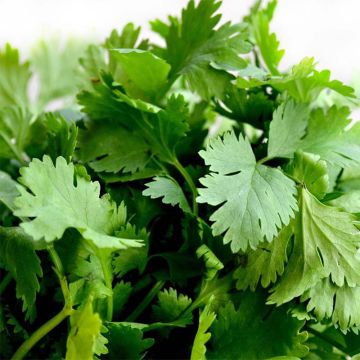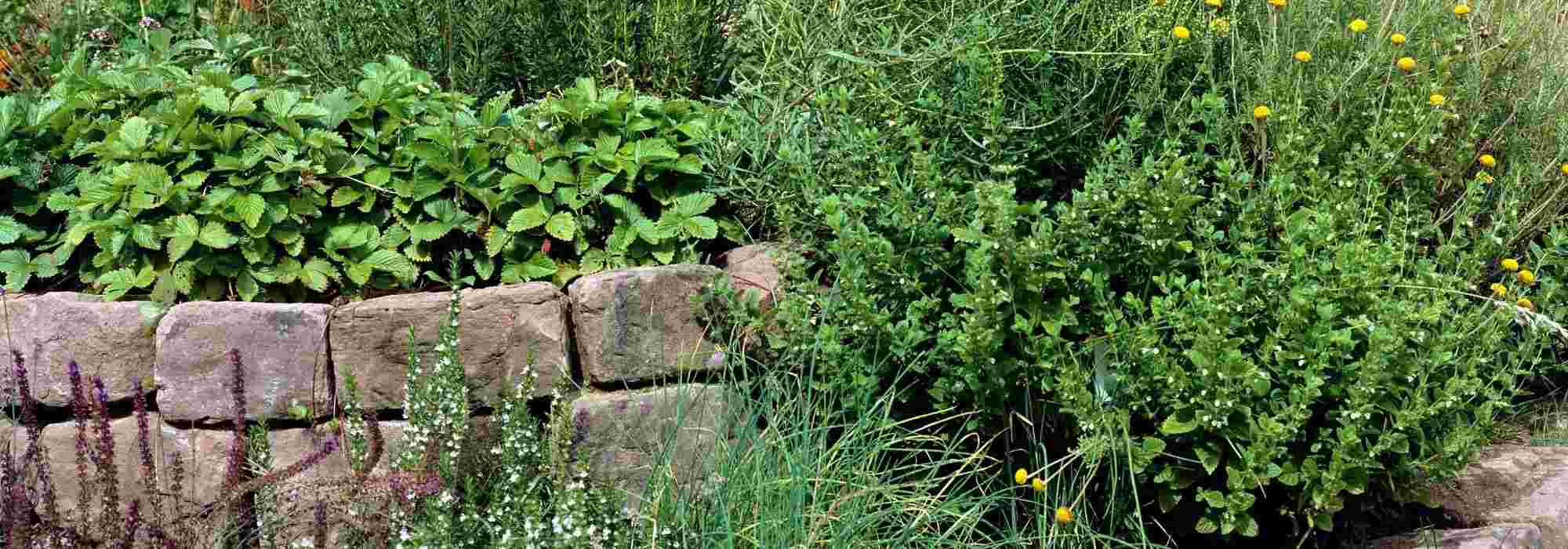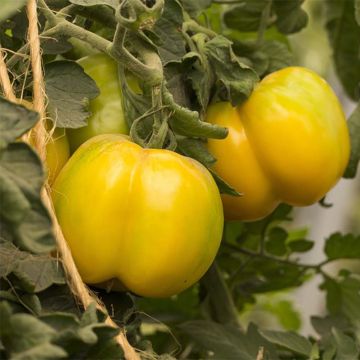

Coriander Eagle plants - Coriandrum sativum
Coriander Eagle plants - Coriandrum sativum
Coriandrum sativum Eagle
Coriander, Cilantro
I planted 5 plants, they all died! Very disappointed...
Anna, 01/08/2023
Special offer!
Receive a €20 voucher for any order over €90 (excluding delivery costs, credit notes, and plastic-free options)!
1- Add your favorite plants to your cart.
2- Once you have reached €90, confirm your order (you can even choose the delivery date!).
3- As soon as your order is shipped, you will receive an email containing your voucher code, valid for 3 months (90 days).
Your voucher is unique and can only be used once, for any order with a minimum value of €20, excluding delivery costs.
Can be combined with other current offers, non-divisible and non-refundable.
Home or relay delivery (depending on size and destination)
Schedule delivery date,
and select date in basket
This plant carries a 6 months recovery warranty
More information
We guarantee the quality of our plants for a full growing cycle, and will replace at our expense any plant that fails to recover under normal climatic and planting conditions.
Description
The 'Eagle' Common Coriander is a variety with good heat resistance and slow bolting. It is a very common aromatic herb in Mediterranean countries, cultivated for its leaves and seeds. This annual plant belongs to the Apiaceae family, sometimes called Cilantro, and can be easily grown in the ground or in pots. These 'Eagle' Coriander seedlings can be planted from April to August, for a harvest from June to October. They are produced using organic methods.
Coriander, like Chervil and Dill, belongs to the Apiaceae family (formerly Umbelliferae) and forms a beautiful plant that can reach a height of 50 cm (20in). It can be grown in full sun or partial shade, in fairly rich soil.
It is a harbal plant with a fairly strong aroma. The leaves add flavour to marinades, fish, and salads. It is best to use it raw, as cooking alters its fragrance a bit. The sweet and lemony-flavoured seeds are perfect with pickles, but can also be ground and used in gingerbread and Indian cuisine.
Harvest: The Coriander (leaves and seeds) can be harvested, depending on the planting dates, from early summer to autumn.
Storage: Coriander leaves can be stored for a few days in the refrigerator or for a few months by drying or freezing. However, it is preferable to consume them freshly picked in order to fully enjoy their fragrance. Once well dried, the seeds can be kept in a paper bag or jar, at room temperature and protected from humidity.
Gardener's tip: To reduce the need for watering, we recommend mulching the soil with thin successive layers of grass clippings, if possible mixed with dead leaves, starting from late May. This protective layer helps keep the soil moist and also reduces weed growth.
Harvest
Plant habit
Foliage
Other Coriander
View all →Planting and care
Coriander thrives in full sun (at the beginning of summer) or partial shade (in the height of summer), in fairly rich soil. If compost is needed, it should preferably be applied in autumn, in the form of well-rotted compost, by raking it in to a depth of 5 cm (2in), after having loosened the soil as is necessary for all vegetable crops.
Planting: Organic Coriander 'Eagle' seedlings can be planted from April to August, for a harvest from June to October.
Space the plants 20cm (8in) apart in all directions. Dig a hole, place the plug plant in it and cover with fine soil. Firmly press down and water.
Coriander can also be grown in pots. Space the plants 15 cm (6in) apart.
Coriander tends to run to seed quite quickly. You can delay this by cutting off the flower stem or providing partial shade in mid-summer.
It is a good companion in the vegetable garden: it stimulates the growth of cucumbers and keeps carrot flies away. Like all Umbellifers, its flowers are highly appreciated by beneficial insects.
Cultivation
Care
Intended location
Planting & care advice
-
, onOrder confirmed
Reply from on Promesse de fleurs
Similar products
Haven't found what you were looking for?
Hardiness is the lowest winter temperature a plant can endure without suffering serious damage or even dying. However, hardiness is affected by location (a sheltered area, such as a patio), protection (winter cover) and soil type (hardiness is improved by well-drained soil).

Photo Sharing Terms & Conditions
In order to encourage gardeners to interact and share their experiences, Promesse de fleurs offers various media enabling content to be uploaded onto its Site - in particular via the ‘Photo sharing’ module.
The User agrees to refrain from:
- Posting any content that is illegal, prejudicial, insulting, racist, inciteful to hatred, revisionist, contrary to public decency, that infringes on privacy or on the privacy rights of third parties, in particular the publicity rights of persons and goods, intellectual property rights, or the right to privacy.
- Submitting content on behalf of a third party;
- Impersonate the identity of a third party and/or publish any personal information about a third party;
In general, the User undertakes to refrain from any unethical behaviour.
All Content (in particular text, comments, files, images, photos, videos, creative works, etc.), which may be subject to property or intellectual property rights, image or other private rights, shall remain the property of the User, subject to the limited rights granted by the terms of the licence granted by Promesse de fleurs as stated below. Users are at liberty to publish or not to publish such Content on the Site, notably via the ‘Photo Sharing’ facility, and accept that this Content shall be made public and freely accessible, notably on the Internet.
Users further acknowledge, undertake to have ,and guarantee that they hold all necessary rights and permissions to publish such material on the Site, in particular with regard to the legislation in force pertaining to any privacy, property, intellectual property, image, or contractual rights, or rights of any other nature. By publishing such Content on the Site, Users acknowledge accepting full liability as publishers of the Content within the meaning of the law, and grant Promesse de fleurs, free of charge, an inclusive, worldwide licence for the said Content for the entire duration of its publication, including all reproduction, representation, up/downloading, displaying, performing, transmission, and storage rights.
Users also grant permission for their name to be linked to the Content and accept that this link may not always be made available.
By engaging in posting material, Users consent to their Content becoming automatically accessible on the Internet, in particular on other sites and/or blogs and/or web pages of the Promesse de fleurs site, including in particular social pages and the Promesse de fleurs catalogue.
Users may secure the removal of entrusted content free of charge by issuing a simple request via our contact form.
The flowering period indicated on our website applies to countries and regions located in USDA zone 8 (France, the United Kingdom, Ireland, the Netherlands, etc.)
It will vary according to where you live:
- In zones 9 to 10 (Italy, Spain, Greece, etc.), flowering will occur about 2 to 4 weeks earlier.
- In zones 6 to 7 (Germany, Poland, Slovenia, and lower mountainous regions), flowering will be delayed by 2 to 3 weeks.
- In zone 5 (Central Europe, Scandinavia), blooming will be delayed by 3 to 5 weeks.
In temperate climates, pruning of spring-flowering shrubs (forsythia, spireas, etc.) should be done just after flowering.
Pruning of summer-flowering shrubs (Indian Lilac, Perovskia, etc.) can be done in winter or spring.
In cold regions as well as with frost-sensitive plants, avoid pruning too early when severe frosts may still occur.
The planting period indicated on our website applies to countries and regions located in USDA zone 8 (France, United Kingdom, Ireland, Netherlands).
It will vary according to where you live:
- In Mediterranean zones (Marseille, Madrid, Milan, etc.), autumn and winter are the best planting periods.
- In continental zones (Strasbourg, Munich, Vienna, etc.), delay planting by 2 to 3 weeks in spring and bring it forward by 2 to 4 weeks in autumn.
- In mountainous regions (the Alps, Pyrenees, Carpathians, etc.), it is best to plant in late spring (May-June) or late summer (August-September).
The harvesting period indicated on our website applies to countries and regions in USDA zone 8 (France, England, Ireland, the Netherlands).
In colder areas (Scandinavia, Poland, Austria...) fruit and vegetable harvests are likely to be delayed by 3-4 weeks.
In warmer areas (Italy, Spain, Greece, etc.), harvesting will probably take place earlier, depending on weather conditions.
The sowing periods indicated on our website apply to countries and regions within USDA Zone 8 (France, UK, Ireland, Netherlands).
In colder areas (Scandinavia, Poland, Austria...), delay any outdoor sowing by 3-4 weeks, or sow under glass.
In warmer climes (Italy, Spain, Greece, etc.), bring outdoor sowing forward by a few weeks.






















































